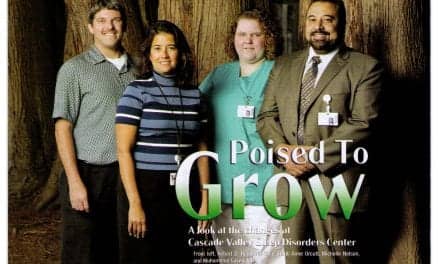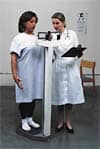A 55-year-old male weighing 375 lbs who had a history of excessive sleepiness and apnea exemplified the problems that may be encountered in inpatient testing.
One of the dilemmas that hospital-based sleep centers face is whether to test inpatients during their hospital stays. Traditionally, testing is done for nonpediatric patients as an outpatient procedure. Depending on the type and size of the hospital base, however, the sleep center may be faced with the challenge of testing patients already admitted to the hospital for other health concerns. While they are undergoing treatment for those illnesses or conditions, a sleep-related disorder may be suspected and a request may be made of the hospital’s sleep center to diagnose and treat that disorder. Technologists may feel pressured to respond immediately to the physician’s request for testing, but that decision must be carefully viewed. Most often, the request is related to the diagnosis and possible treatment of sleep-related breathing disorders, as these disorders have a dynamic, devastating effect on patients’ health. The relevant questions then become whether, when, and where to perform testing. In response to these requests, some centers have a firm policy not to perform any inpatient sleep testing services, while others determine on a case-by-case basis what course is best for the patient. If the sleep center’s policy is to proceed with ordered testing on inpatients, the course of that testing must be well planned, must allow for the unique needs of inpatients, and must be supported by technical and medical staff.
Testing Inpatients
Testing inpatients can be extraordinarily challenging. Admission requirements, affected by a number of factors, have become increasingly stringent. It follows that today’s inpatient may be significantly more ill than the inpatient of years past. Undergoing treatment for a variety of medical concerns and being away from home, this patient is probably neither resting well nor resting for long periods of time. Multiple medical concerns prompt multiple tests and procedures, and one more test is just too much; there may be too little sleep to study. The patient’s sleep patterns may also be so disturbed by routine hospital monitoring and treatment that inpatient testing would result in documenting sleep patterns that do not represent the patient’s current baseline state, making the test one of limited value. Consequently, many hospital-based sleep centers do not perform sleep studies on inpatients, delaying the procedure until the patient’s condition stabilizes and he or she is able to return to the sleep center on an outpatient basis. The point of this delay is to allow for a normalization period so that the patient’s sleep pattern can recover from the awakening intrusions of the inpatient regimen.
Another approach considers that a potential sleep-related need has been identified and that this identification warrants immediate investigation and care. How can that diagnosis and treatment best be provided? Investigation can be undertaken through bedside testing in the patient’s hospital room or after transfer into the hospital-based sleep center for polysomnography. Careful planning must be done before using either method. Comprehensive assessments of the patient’s status (physical, mental, and respiratory), sleep-related needs, and nursing and support requirements, as well as financial circumstance, must be carefully viewed to determine the best course for the patient’s care. The goal of this assessment will be to ensure that the polysomnogram will be of sufficient value to the patient and physician to permit high-quality, safe care to be based on the results.
Protocols and Procedures
It has been the experience of most centers that fully developed protocols and procedures for data acquisition and treatment are critical and must be in place to ensure patient safety and high-quality studies. Inpatients usually have several common complaints. As their conditions are often respiratory, many have a history of chronic obstructive pulmonary disease. Many are obese and may have diabetes and, often, a restrictive component of the suspected disorder. Hypertension is very common, as well as a history of transient ischemic attack (TIA) or cerebrovascular accident (CVA). The TIA or CVA may also create the concern that dementia may be present; moving affected patients to new environments may prove especially challenging.
Assessment criteria for testing should include blood-sugar level, arterial blood-gas (ABG) levels, and blood pressure, as well as appropriate scales for identifying reported laboratory values that are outside normal ranges. These panic levels are often good yardsticks for use in choosing the testing location.
Unfortunately, the sleep laboratory staff must also consider the cost of testing and the very real possibility that sleep testing will not be paid for if it is performed during hospitalization. Polysomnography consists of comprehensive protocols that quantify the function of multiple mechanisms, producing time-synchronized results. Such results are tremendously valuable to the clinician. The expenses incurred are in proportion to the large amount of information gathered. Many of these patients are admitted under Medicare’s prospective payment system, so the additional sleep-testing costs would not be reimbursable. Therefore, consideration must be given to financial constraints; a sleep center is a business and must remain fiscally responsible in order to provide services.
Testing Location
Regardless of the testing location, health care professionals realize that the cornerstone of medicine is, first and foremost, to do no harm. Patient safety must be of the utmost concern, and every consideration must be given to safety in selecting a testing location.
For many centers, the ideal testing choice is for the sleep test to be performed at the inpatient’s bedside. This can be very difficult, as the patient generally is quite ill. This necessitates the use of properly trained sleep professionals, as well as appropriate, adequate testing equipment that enables the technologist to perform a comprehensive, high-yield polysomnogram. The currently recognized clinical need for inpatient testing is related to sleep-associated breathing disorders. An informal poll of hospital-based centers indicates that the most requested test is for previously undiagnosed or noncompliant apnea patients, often with a concomitant restrictive component to their respiratory distress. Their disorders were untreated or undertreated prior to hospitalization, and apnea or a related respiratory concern may have already resulted in cardiac and cerebrovascular consequences. Many patients have already suffered a significant CVA or myocardial infarction and have been admitted for those illnesses.
Due to the complexity of these patients’ needs, patients in this group are usually admitted into coronary care, intensive care, or CVA-monitoring units. These patients are often quite ill and very much in need of the respiratory, nursing, and medical support that such a unit can provide. With this in mind, the sleep center may opt to bring the technologist and sleep testing system to the inpatient’s bedside and perform the polysomnography there. Bedside testing may involve complete polysomnography, with electroencephalography, electro-oculography, electromyography, electrocardiography, oximetry, respiratory effort monitoring, and airflow monitoring. In some cases, a more limited screening system may be used to provide preliminary information while the patients waits until a full polysomnogram can be performed. Unfortunately, these limited (and, often, unattended) studies may be of limited value to a patient with multiple medical concerns. Whether the study is comprehensive or limited, however, bedside polysomnographic testing creates minimal disruption in the patient’s overall care and comfort.
As wonderful as a bedside, comprehensive inpatient testing service can be, not all sleep centers have the manpower or funds to be able to offer this service. Throughout the United States, there is a shortage of trained polysomnographers; this prohibits many centers from providing even sufficient outpatient testing, much less permitting them to offer inpatient bedside testing. Further, the caliber of technologist required for inpatient testing is quite high. This individual should be a polysomnographer experienced in all aspects of patient care, comfortable in various critical care areas, able to work with the team of professionals in that area, and especially adept at troubleshooting and adaptability. Invariably, there are equipment and logistical challenges any time that a facility offers a portable service. One commonly encountered challenge is that critical care units are equipped with multiple telemetry systems and other potential sources of electrical interference that can hamper the acquisition of a clean sleep tracing, though it should be noted that newer sleep systems can often limit this input conflict.
The shortage of sleep technologists is not limited to those with experience. From entry-level to management-level polysomnographers, nationwide shortages of capable staff create delays in care at many sleep centers. Many sleep facilities report a 2-week to 4-week wait for scheduled outpatient testing, with some centers even reporting backlogs of 1 to 2 months or more. Such facilities simply do not have the luxury of designating staff and equipment for bedside testing. Consequently, the challenge that they face is often one of employing experienced technologists, having portable testing systems available, and instituting procedures and protocols that promote high-quality, effective, safe bedside polysomnography.
Many sleep centers opt to provide services for inpatients by bringing them to the sleep center for testing and possible treatment. This choice may be influenced by staffing concerns, but can also be prompted by a feeling that the test can be performed best in a quiet, electrically clean environment. It cannot be stressed enough, however, that patient safety is of paramount concern; bringing an inpatient into the sleep center should be done only after careful assessment.
To optimize the chances of successful sleep testing, a physician associated with the sleep center should see the patient prior to the test to determine the immediacy of need, to initiate proper orders, to determine test protocols (apnea and split night), to assess sleep-related medication needs, and to explain to the patient the overall course of care and areas of concern. In addition, a member of the center’s technical staff should visit the patient at least 6 to 8 hours prior to testing. This gives the technologist the opportunity to explain the polysomnographic procedure thoroughly to patients, their caregivers, and their family members. Given the rush and complexity of inpatient diagnosis and treatment, these patients often feel overwhelmed and anxious about their conditions and courses of care. For many, hospitals are frightening places; anxious, nervous patients rarely sleep well. A few moments of preparatory time and discussion with patients can allay their fears and make the difference between a successful test and a failed effort. Further, instructions should be given to the patient’s nurse to assist the patient in avoiding caffeine and naps until the test has been completed.
Challenges
Whether inpatient testing is performed at bedside or in the sleep center, it is associated with other challenges. The patient may have been hospitalized for an extended period on a monitored unit and, therefore, may have been unable to shower or to shampoo his or her hair. Many hospitals have a policy preventing showering or exposure to water for all patients who have venous or arterial catheters, for example. If the hair is extremely oily or dirty, electrode application may prove difficult. These patients may also require assistance with restroom or bedpan use. Respiratory patients may need oral or nasal aspiration of secretions. In the post-CVA patient, special assistance with moving and positioning may be needed. The areas where patients with dementia are tested may require soundproofing so that other sleep-testing patients can remain undisturbed. Safeguards such as padded bedside rails may also be needed. Additional medical devices, such as intravenous equipment and feeding pumps, may create a challenge with regard to handling and space requirements.
Respiratory treatments and medications may be required during the testing time. Many sleep centers have RCPs on staff, but few are staffed by nurses. These medication and treatment needs also require an interdisciplinary team effort involving nursing, respiratory, and sleep staff, making it more difficult to obtain a high-quality sleep test. Most hospitals’ nursing staffs are already thinly stretched, and it may be difficult for the patient’s floor or unit nurse to leave that area and come to the sleep center to medicate the patient. All of these considerations necessitate the efforts of capable sleep staff in sufficient numbers to coordinate the inpatient’s care in the sleep center.
Case Study
A patient whose case exemplified the problems that may be encountered in inpatient testing was seen at Spartanburg Regional Medical Center Sleep Center, Spartanburg, SC, on January 10, 2002. The patient was a 55-year-old male weighing 375 lbs who had a history of excessive sleepiness and apnea. His Epworth Sleepiness Scale score was 24 of 24. He was a maintenance worker with a history of falling asleep on the job. A nonsmoker, he had become progressively short of breath over the preceding few months. He presented with peripheral edema with a notation of significant anasarca on the day of admission, with a weight gain of more than 9 kg in the proceeding 2 weeks. His blood pressure was 136/68, his respiratory rate was 18 breaths per minute, his heart rate was 78 beats per minute, and his temperature was 37.4°C. An examination of the chest revealed a few crackles at the lung bases without wheezes, rhonchi, or rubs. Because of left and right heart failure and hypoxemia, the patient was admitted to the coronary care monitoring unit. This patient related to our staff that he had undergone a sleep study approximately 10 years earlier. Continuous positive airway pressure (CPAP) therapy had been prescribed, but but he had only used the CPAP unit consistently for 2 to 3 months, and he had not used it regularly since that time. His prognosis was listed as guarded.
The patient was transported from the monitored unit to our sleep center, which was in an adjacent building. We currently test five patients per night, with three technologists in attendance. The patient’s technologists included three registry-eligible polysomnographers one of whom is also a registered respiratory therapist. When the patient entered the sleep center, monitoring for oxygen saturation via pulse oximetry was initiated, along with supplemental oxygen delivered via nasal cannula at a flow rate of 2 L/min.
At the beginning of the study, the patient preferred sleeping in the supine position and was immediately noted to be asleep and experiencing oxygen desaturations, with saturation levels as low as 50% to 60%. These desaturations were associated with obstructive sleep apnea, and the patient’s baseline oxygen saturation was returning only to 70% to 80%. CPAP was initiated, in keeping with our split-night protocol, using a bilevel unit with pressure quickly advanced to 10 cm H2O (with in-line supplemental oxygen at a flow rate of 2 L/min). Saturation barely improved.
The attending physician and center manager were contacted and orders were given to increase positive airway pressure and supplemental oxygen flow. Our physician also contacted the patient’s floor nurse. Our technologist then changed to bilevel support and over the next 90 minutes, pressures were increased to a level of 18 cm H2O of inspiratory pressure and 14 cm H2O of expiratory pressure with oxygen supplementation at 4 L/min. Our hospital system’s nursing supervisor came to our center to review the case and assist. The Respiratory Care Services department was notified in case its support might be needed. Our patient’s floor nurse came to the sleep center and administered 40 mg of furosemide intravenously per the sleep center physician’s order. Sleep, up to this point, had been very fragmented, but when the oxygen flow rate was increased to 6 L/min, he entered rapid–eye-movement sleep. The frequency of events diminished, but oxygen saturation remained in the 70% to 80% range. Pressures were increased to 20 cm H2O of inspiratory pressure and 16 cm H2O of expiratory pressure and the head of the bed was raised to a 60° angle, all without successfully maintaining the patient’s oxygen saturation or alleviating his apnea. Our patient awakened, pulling off electrode wires and the bilevel mask. He was very confused and disoriented. Our physician was then contacted and the patient was returned to his monitored bed in our heart center. He was accompanied back to the floor by our technologist, transport services staff, and respiratory care staff.
The patient underwent surgery to create a tracheostomy later that morning. At last report on January 21, 2002, he is managing fairly well using transtracheal oxygen and has lost more than 18 kg.
Discussion
This case demonstrates the very real safety concerns that may arise in performing sleep tests on inpatients. Our staff did some things very well in the care of this patient; we also identified areas for improvement, such as the assessment of ABG levels. The patient had an ABG sample analyzed 30 hours prior to the sleep test that showed a Pco2 of 80 mm Hg. Our center has now developed an assessment protocol specifically examining ABG levels. Any reported Pco2 of more than 60 mm Hg immediately calls for assessment by our center’s medical director to ensure that the patient is stable enough to be cared for in our sleep center. If an ABG analysis has not been done in the previous 12 to 24 hours, one will be ordered to aid in this assessment.
In the past, polysomnographers were challenged by the need to acquire adequate technology and, often, space for testing. Modern sleep systems allow great flexibility in testing location and offer wonderful information, but are not yet perfect. Then or now, the key to polysomnography is having thoroughly prepared technologists who work closely with center physicians to provide safe, accurate testing with the patient’s needs always in mind.
Shari Angel Newman, RPSGT, is manager, Spartanburg Regional Medical Center Sleep Center, Spartanburg, SC.
Acknowledgement
The author would like to give special thanks to Walter W. Holland, REEGT, RPSGT, clinical coordinator of the Neurophysiology Department, University of Tennessee Medical Center, Knoxville, for his assistance with this article.




